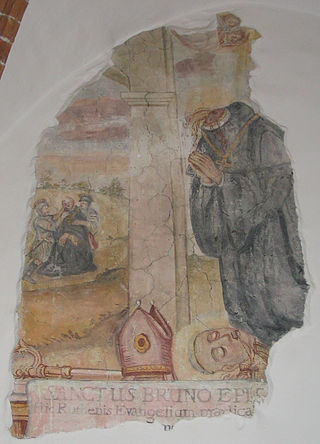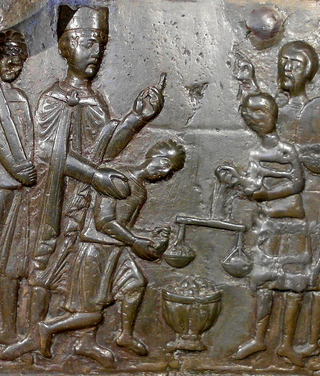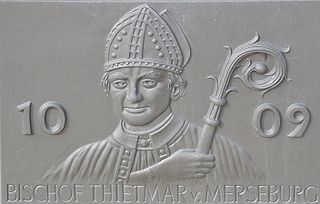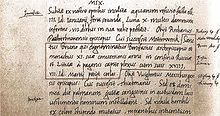
Adelaide of Italy, also called Adelaide of Burgundy, was Holy Roman Empress by marriage to Emperor Otto the Great. She was crowned with him by Pope John XII in Rome on 2 February 962. She was the first empress designated consors regni, denoting a "co-bearer of royalty" who shared power with her husband. She was essential as a model for future consorts regarding both status and political influence. She was regent of the Holy Roman Empire as the guardian of her grandson in 991–995.

Bruno of Querfurt, O.S.B. Cam.,, also known as Brun, was a Christian missionary bishop, Camaldolese monk and martyr, who was beheaded near the border of Kievan Rus and Lithuania for trying to spread Christianity. He is also called the second "Apostle of the Prussians".

Géza, also Gejza, was Grand Prince of the Hungarians from the early 970s. He was the son of Grand Prince Taksony and his Oriental—Khazar, Pecheneg or Volga Bulgarian—wife. He married Sarolt, a daughter of an Eastern Orthodox Hungarian chieftain. After ascending the throne, Géza made peace with the Holy Roman Empire. Within Hungary, he consolidated his authority with extreme cruelty, according to the unanimous narration of nearly contemporaneous sources. He was the first Hungarian monarch to support Christian missionaries from Western Europe. Although he was baptised, his Christian faith remained shallow and he continued to perform acts of pagan worship. He was succeeded by his son Stephen, who was crowned the first King of Hungary in 1000 or 1001.

Bolesław I the Brave, less often known as Bolesław the Great, was Duke of Poland from 992 to 1025, and the first King of Poland in 1025. He was also Duke of Bohemia between 1003 and 1004 as Boleslaus IV. A member of the ancient Piast dynasty, Bolesław was a capable monarch and a strong mediator in Central European affairs. He continued to proselytise Western Christianity among his subjects and raised Poland to the rank of a kingdom, thus becoming the first Polish ruler to hold the title of rex, Latin for king.

Henry I, known as Henry the Strong, was the Margrave of Austria from 994 to his death in 1018. He was a member of the House of Babenberg.

Bruno, also called Brun or Braun, a member of the Ottonian dynasty, was Duke of Saxony from 866 until his death in 880. He is rated as an ancestor of the Brunonids, a cadet branch of the Ottonians, though an affiliation is uncertain. Bruno was killed fighting against Norse warriors in the Battle of Lüneburg Heath and is venerated as one of the Ebsdorf Martyrs.

Thietmar, Prince-Bishop of Merseburg from 1009 until his death in 1018, was an important chronicler recording the reigns of German kings and Holy Roman Emperors of the Ottonian (Saxon) dynasty. Two of Thietmar's great-grandfathers, both referred to as Liuthar, were the Saxon nobles Lothar II, Count of Stade, and Lothar I, Count of Walbeck. They were both killed fighting the Slavs at the Battle of Lenzen.

Memleben Abbey was a Benedictine monastery in Memleben on the Unstrut river, today part of the Kaiserpfalz municipality in Saxony-Anhalt, Germany. The convent, now ruined, was established by Emperor Otto II and his consort Theophanu about 979.
Count Lambert "the Bearded" was the first person to be described as a count of Leuven in a surviving contemporary record, being described this way relatively late in life, in 1003. He is also the patrilineal ancestor of all the future counts of Leuven and dukes of Brabant until his descendant John III, Duke of Brabant, who died in 1355.
Dietrichof Haldensleben was a count in the Schwabengau, later also in the Nordthüringgau and the Derlingau, who was the first Margrave of the Northern March from 965 until the Great Slav Rising of 983. He also bore the title of a dux (duke) in contemporary sources.He was a ancestor of John V
Gunther was the Margrave of Merseburg from 965 until his death, upon which the march of Merseburg was united to that of Meissen.

Quedlinburg Abbey was a house of secular canonesses (Frauenstift) in Quedlinburg in what is now Saxony-Anhalt, Germany. It was founded in 936 on the initiative of Saint Mathilda, the widow of the East Frankish King Henry the Fowler, as his memorial. For many centuries it and its abbesses enjoyed great prestige and influence. Quedlinburg Abbey was an Imperial Estate and one of the approximately forty self-ruling Imperial Abbeys of the Holy Roman Empire. It was disestablished in 1802/3. The church, known as Stiftskirche St Servatius, is now used by the Lutheran Evangelical Church in Germany.

Adelaide I, a member of the royal Ottonian dynasty was the second Princess-abbess of Quedlinburg from 999, and Abbess of Gernrode from 1014, and Abbess of Gandersheim from 1039 until her death, as well as a highly influential kingmaker of medieval Germany.
Gyula III, also Iula or Gyula the Younger, Geula or Gyla, was an early medieval ruler in Transylvania. Around 1003, he and his family were attacked, dispossessed and captured by King Stephen I of Hungary (1000/1001-1038). The name "Gyula" was also a title, the second highest rank in Hungarian tribal confederation.

The German–Polish War consisted of a series of struggles in 1003–1018, between the Ottonian king Henry II of Germany and the Polish Piast ruler Bolesław I the Brave. The locus of conflict was the control of Lusatia, Upper Lusatia, as well as Bohemia, Moravia and Slovakia. The fighting ended with the Peace of Bautzen in 1018, which left Lusatia and Upper Lusatia as a fief of Poland, and Bohemia became a duchy in the Holy Roman Empire.

Robert, also spelled Ruotbert or Rotbert, was the archbishop of Trier from 931 until his death. He played a leading role in the politics of both Germany and France, and especially of the Lotharingian territory in between. He was a patron of scholars and writers and a reformer of monasteries.
Friedrick, Count of Walbeck and Viscount (Burggraf) of Magdeburg, son of Siegfried I the Older, Count of Walbeck, and Kunigunde von Stade daughter of Henry I the Bald, Count of Stade. He was brother to Thietmar of Merseburg, whose Chronicon was the main source of information on him, and his predecessor Henry, Count of Walbeck.
Werner, Count in Hesbaye was a count in Hesbaye, now in Belgium. During his life he held lands in the Condroz, and lands as far away as Zülpich, now in Germany. All the areas he was associated with were part of the Kingdom of Lotharingia, which during this period was no longer independent, but mainly under the control of Germany.
Adela of Hamaland, was countess of Hamaland in the Netherlands in about 973–1021. She was also the regent of Renkum in circa 983–?, likely as regent for her son Dirk of Renkum. Her claim on the inheritance of her father caused a conflict with her sister Liutgard of Elten, which lasted from 973 until 996. She first married Count Immed of Renkum, the father of her son, and later Count Balderik of Hamaland, whom she made her co-regent by marriage.
Hathui was a member of the Saxon House of Billung, who was the first abbess of Gernrode (r.959-1014).












